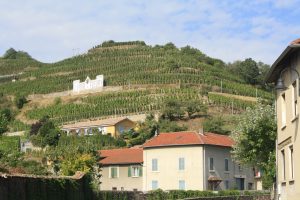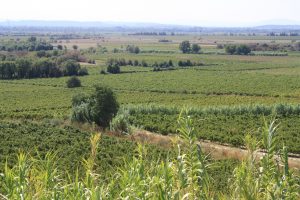Despite the headline, you can’t visit France, because France isn’t just one place. (These days, you actually can’t visit France at all because of the pandemic.) The country is so varied that you can’t take it all in, either as a visitor or even as a resident. It’s cities and countryside and mountains and beaches and, of course, vineyards.
For a wine lover, visiting France is to have a little time in paradise, and almost every sector of the country grows grapes for wine. But the grapes in those vineyards differ tremendously, even those a short distance from each other. For example, if you start in the city of Lyons and drive just a half hour northwards, the vines hang heavy with Gamay and the wines are Beaujolais. The whites are Chardonnay, as they are just a bit north of Beaujolais but the red grapes are Pinot Noir.
The terraced vineyards of the Côte Rôtie.
If you leave Lyons in the other direction, again just a half hour away, you’re in the Northern Rhône and the red grapes are mostly Syrah and the whites Roussanne and Marsanne. By comparison with America, the Northern Rhône and Beaujolais are as far apart as Carneros and Calistoga; imagine totally different production between one end of Napa Valley and the other.
The heart of Champagne is only a few hours’ drive from the heart of the Côte d’Or in Burgundy. Yes, they both grow Pinot Noir and Chardonnay, but the wines they make are totally different. So are the foods, the castles and the history of the two regions. It is not hard to envelope yourself in either place but there is a wrenching disconnect if you travel between them.
Further west, the Loire Valley, also known as the Touraine (for the city of Tours) is best known for Sauvignon Blanc. The best-known red wine is Chinon, made from Cabernet Franc, although there is plenty of Gamay grown as well. These wines, for the most part, are not as grand as those of Burgundy and Bordeaux, but they do make pleasant drinking.
The broad expanse of vineyards in the Languedoc.
Speaking of Bordeaux, the majestic red wines grown there are primarily Cabernet Sauvignon, Merlot and Cabernet Franc, with Sémillon the major grape for white wines. For the travelling wine taster, Bordeaux is the most difficult to visit and surely the snobbiest part of France. By contrast, head either east from Bordeaux to the Southern Rhône Valley or south to Languedoc and the red grapes are Grenache, Syrah and Mourvèdre and the whites are Viognier and Picpoul, among others. (Actually, in Languedoc, you’ll find a little of everything.)
And so, our advice to our wine tasting friends is not to try to visit France all at once. Instead, focus on one or at most two regions at a time. Get to know the people, the villages, the roads, the markets, the foods and of course the wines. Historically, France was stitched together from many distinct regions. To this day, a Breton and a Provençal have accents as different as a Brooklynite and a Texan. Yes, they talk the same language, but with very different accents. But the US is a very big country and France is relatively small. Going a short distance in France can change everything, from the wine to the architecture to the cuisine. But it’s all France.

